
PART ONE: THE BASIC FRAMEWORK

Figure 1: Assessment is built on the content standards
THE PURPOSE OF SOCIAL STUDIES
Social studies is defined as the integrated study of the social sciences to prepare young people to become responsible citizens. As Figure 1 shows, the social studies curriculum builds four capacities in young people: disciplinary knowledge, thinking skills, commitment to democratic values, and citizen participation. Each capacity contributes uniquely to the development of responsible citizenship. Social studies draws primarily upon the disciplines of history, geography, economics, and American government as provided by Public Act 335 of 1993. The 25 standards listed in the Social Studies Content Standards of the Michigan Curriculum Framework establish expectations for what students are expected to know and be able to do as a result of their social studies education.
The Social Studies Content Standards are grouped into seven categories called strands. The standards, expressed as attributes we envision for our graduates, are the intended results of students experience with a core curriculum. Students are expected to make continuous progress toward meeting the standards at each level of schooling. All of the standards should be pursued at every grade level of a core curriculum from kindergarten through graduation. As Figure 2 shows, they spiral through the curriculum. Benchmarks are established for each standard to designate more specifically what students are expected to learn by the end of the early elementary grades, the later elementary grades, middle school, and high school to indicate their progress toward meeting the standards.

Figure 2: Building towards the goal of responsible citizenship
MEAP AND THE GRADE 8 TEST AS PART OF A COMPREHENSIVE ASSESSMENT SYSTEM
An assessment system should consist of statewide assessment, assessment at the local level, and performance standards that link assessment to the content standards. The primary purpose of assessment should be the improvement of teaching and learning, and no single assessment instrument can provide all the information needed to accomplish this purpose. An integrated approach to assessment, in which all social studies content standards and benchmarks are assessed with the most appropriate assessment methods available, is needed.
PURPOSE OF STATEWIDE ASSESSMENT
The statewide social studies assessment is designed to provide information about student social studies achievement, promote assessment practices that support learning for all students, and foster teaching that is aligned with the state Social Studies Content Standards. This assessment information can be used by students, parents, teachers, school districts, researchers, and state government to advance the quality of social studies education.
STANDARDS ASSESSED AT THE STATE LEVEL
Statewide assessment is based on the Content Standards for Social Studies of the Michigan Curriculum Framework. Some of those standards are not conducive to state testing and must be assessed locally. The 22 content standards to be assessed by statewide tests are presented in Figure 3.
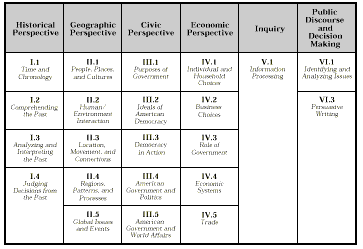
Figure 3: Social studies standards to be assessed
RESPONSE FORMATS
State tests will feature three types of response formats. Each type will pertain to a prompt or prompts consisting of a passage, map, chart, graph, drawing, photograph, or a combination of these. All three types of responses will require students to remember what they have learned ( activate prior knowledge) and to analyze information presented by the prompt. The three types of response formats are:
Selected: Students select a response from a group of possible choices. These items are a form of enhanced multiple-choice items and take approximately one minute each to complete. Selected-response items will be presented in five-item clusters that use a common prompt.
Constructed: Students generate a reply that they have created based upon their prior knowledge and information presented in a prompt at the time of testing. A constructed response should take students no more than five minutes to complete and could be expressed in various forms, e. g., a paragraph, table, map, chart, or graph.
Extended: An extended response should take no more than 15 minutes to complete. Students compose an essay that addresses a public policy issue. They will be asked to interpret and use data provided in the prompt. Students must also demonstrate what they know from history, geography, civics, or economics, and their understanding of core democratic values of American democracy in their response.
DISTRIBUTION OF ITEMS BY STRAND AND TYPE OF FORMAT
Figure 4 shows how the items for each test will be distributed by strand and type of response format. The number of items for each test has been set. Selected-response items will be worth 1 point, constructed-response items 2 points, and extended-response items 4 points. On the grade 8 test, 42 of the 61 points possible are assigned to selected-response items. In other words, about one-third of the total score is attributed to open- ended items on the statewide tests.
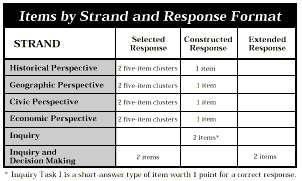
Figure 4: Distribution of items Grade 8
CONTEXTS FOR ITEM SELECTION
The Content Standards for Social Studies of the Michigan Curriculum Framework should be addressed at every grade level and course. Consequently, all of the 22 standards being assessed statewide will be incorporated in each test. Items will be designed to reflect the appropriate grade- level benchmarks for those standards. Standards and benchmarks, however, are not unique to a particular context of a social studies curriculum. Consider Standard I. 1 (Time and Chronology), for example. Students could make progress toward meeting this standard when studying the history of their local communities, when studying the early history of the United States, when studying the recent history of the United States, or when studying medieval Europe or ancient China, to name only some of the possibilities. Similarly, for Standard II. 1 (People, Places, and Cultures) students could make progress toward meeting this geographic standard by studying any of several regions locally, nationally, or globally.
Not all possible eras in history nor regions in geography could be included on the state social studies tests. Nor could all the possible contexts from the civics or economics strands be included. To a large extent, the choice of contexts for the social studies curriculum is a local decision. The Social Studies Content Standards adopted by the State Board of Education do not specify the particular subject matter for a social studies curriculum. Some assumptions about the content of the social studies curriculum, however, have been made to guide the design of state assessments. These assumptions are derived from the benchmarks that support the state Social Studies Content Standards and from curriculum patterns in Michigan schools.
With no assumptions about the content of the curriculum, there would be no basis for determining an appropriate curricular context for testing. Broad contexts have, therefore, been identified as a basis for constructing state assessment items. These contexts should also be considered when designing a local core curriculum for social studies.
CONTEXT FOR ITEM SELECTION MEAP TEST GRADE 8
Appropriate contexts for the social studies curriculum from grade 5 to the middle of grade 8, and, therefore, the contexts for eighth grade MEAP testing, include United States history until 1815; major regions and cultures of the world in Africa, Asia, Europe, North and South America, and Oceania; constitutional foundations of American government; and the economy of the United States. Local districts that so desired could incorporate more recent eras of American history in the curriculum, but they should expect eighth grade MEAP testing to be limited to the time prior to 1815. As with fifth grade MEAP testing, the geographic, civic, and economic contexts include both the past and present.
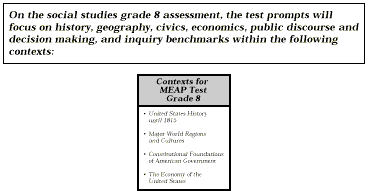
Figure 5: Contexts for test items for state assessment of social studies
The chart in Figure 5 summarizes the contexts to be used for preparing state assessment items. A local curriculum that addresses the benchmarks within these contexts would help prepare students for state assessment by aligning what is taught with what is tested.
SAMPLE GRADE 8 ITEMS
To help educators anticipate the kinds of items being planned for state assessments, this document includes a complete released form of this test for grade 8.
The Social Studies Assessment Model reflects a commitment to constructed- and extended- response items because these types of items are necessary to determine the extent to which students are meeting the Content Standards. The scoring guides that will be used to score these items follow the released form in Part Three of this document.
ASSESSMENT REPORTS
The results of the social studies assessments will be reported by the strands of the Content Standards. The following strands will be reported:
Historical Perspective (all standards)
Geographic Perspective (all standards)
Civic Perspective (all standards)
Economic Perspective (all standards)
Inquiry and Decision Making (Standards SOC. V. 1, Information Processing; SOC. VI. 1, Identifying and Analyzing Issues; and SOC. VI. 3, Persuasive Writing)
Local districts, with the help of the Michigan Department of Education and intermediate school districts, will be encouraged to design reporting instruments for the benchmarks and standards assessed locally. For example, administrators and teachers may want to discuss how evidence of their students group discussion skills (Standard SOC. VI. 2) might be collected and reported. As they are developed and used, examples of successful local district assessments and reporting procedures will be shared with all districts across the state.
PART TWO: RELEASED TEST FORM
MICHIGAN EDUCATION ASSESSMENT PROGRAM
MEAP

GRADE 8 SOCIAL STUDIES ASSESSMENT MODEL
SPRING 1998
Day One: Social Studies Assessment Instructions to the Student
There are three types of questions on this test: selected- response, constructed- response, and extended- response.
Selected- response questions will ask you first to read a passage, map, chart, or table. After studying this prompt, read the questions and choose the best answer from among four answer choices.
Constructed- response questions will ask you to explain a conclusion, provide examples, complete a chart, interpret information, or give a reason for an answer you have given.
Extended- response questions require you to write an answer that is more detailed and requires more thinking. These items ask you to interpret information from a set of data on an imaginary policy issue, identify a relationship presented in the Data Section, take a position for or against the policy, and give reasons supporting your position.
Use the separate answer sheet to mark your choice for the selected- response questions. Fill in the circle for your choice on the answer sheet. Remember to fill in the circle completely and cleanly, erasing any stray lines or marks.
Space is provided in the test booklet for you to write your answers for constructed- response and extended- response items. Read all directions for these items carefully. If you finish early, you may check your work for Day One only. Do not go ahead and work on the Day Two section of this test.
Read the following sample selected- response item to yourself and answer the question. (Sample Selected- response Prompt and Question)
Directions: Read the following map and passage and use them with what you already know to answer the questions that follow.
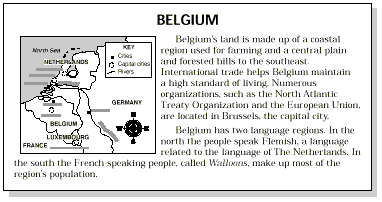
S1 What is the MAIN reason why foreign financial businesses have located in Brussels, Belgium?
*A Brussels is the location of many international organizations.
B Brussels is the oldest city within the Benelux countries.
C Brussels is a major center for imports and exports.
D Brussels is centrally located in Belgium.
Read the following sample constructed- response item and the answer that a student has written.
(Sample Constructed- response Item)
Directions: You should take about 5 minutes to study the following timeline and use it with what you already know to complete this task.
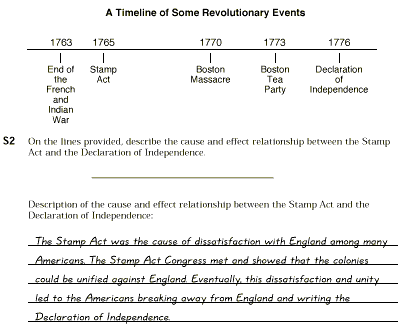
(Sample Extended- response Item)
Directions: Read the following imaginary information about a public policy issue. Use it with what you already know to complete the tasks that follow. You should take about 20 minutes to complete both Task I and Task II. Task I is a selected response item and Task II is an extended- response item.

(Sample Extended- response Item continued)
COMPLETE THE FOLLOWING TASKS: Task I: Interpreting Information
S3 Study the information in the Data Section. Which of the following statements best describes the relationship between size of student population and average percentage of student athletes testing positive for illegal drugs? Be sure to mark your answer on the answer sheet.
A As the average size of schools increases, the average percentage of student athletes testing positive for illegal drugs increases.
B The use of illegal drugs by student athletes causes school size to increase.
C School size causes increased use of illegal drugs by student athletes.
D As school size increases, illegal drug use by student athletes decreases.
Task II: Taking a Stand
S4 You will now take a stand on the following public policy issue: Should the state legislature require student athletes to take random, mandatory tests for illegal and/ or performance- enhancing drugs? You may either support or oppose student athletes being required to take these tests for drugs. Write a letter to your state representative. Use information to provide reasons that support your position.
You will be graded on the following, so be sure your letter includes each of the elements listed below:
Remember to: Use complete sentences.
Should the state legislature require student athletes to take random, mandatory tests for illegal and/ or performance- enhancing drugs?
Dear State Representative:
(In the operational test booklet, a sample student response will be printed here.)
Directions: Study the following maps and use them with what you already know to answer the questions that follow.
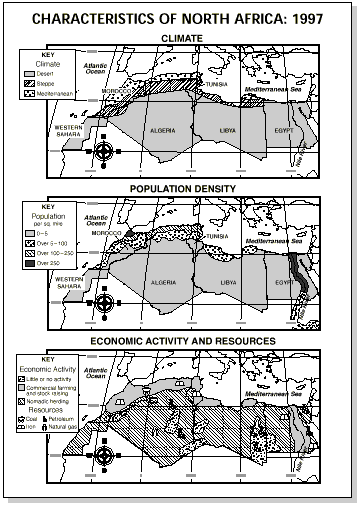
1 Where does MOST of the agricultural activity of North Africa take place?
A Along the Red Sea
B Along the Egyptian and Libyan border
C Along the Algerian and Libyan border
D Along the Mediterranean coast and along the Nile River
2 How does the importance of the Nile River to Egypt today compare to its importance to ancient Egypt?
A Egyptians today view the Nile River as a source of flood problems.
B Egyptians in ancient times did not depend on the Nile River for agriculture.
C Egyptians today and in ancient times depended on the Nile River for agriculture.
D Egyptians today use modern technology and do not depend on the Nile River for agriculture.
3 Which of the following BEST describes the climate of North Africa?
A Most of North Africa has a Mediterranean climate.
B Most of North Africa has a desert climate.
C The southern part of North Africa gets the most rain.
D The driest areas of North Africa are near the Mediterranean coast.
4 How is agriculture possible in the climate of Egypt?
A Agriculture takes place in the areas that have a Mediterranean climate.
B Egypt receives an adequate amount of precipitation.
C The Nile River valley has fertile farmland.
D Most agricultural activity takes place far inland.
5 Which of the following statements BEST explains the population density of North Africa?
A The population density is lower in areas that have the resources to support life.
B The population density is higher in areas that have the resources to support life.
C The population density is highest along the border of Libya and Algeria.
D The population density is highest near areas that produce petroleum.
Directions: Read the following passage and use it with what you already know to answer the questions that follow.
NOMADIC CULTURES
Nomads are people whose way of life makes them move from place to place. There are three types of traditional nomadic cultures: hunters and gatherers; pastoral nomads, who herd animals; and craftsmen and traders. Here are descriptions of four traditional nomadic cultures. As time passes, more and more members of these nomadic cultures are settling in towns and cities.
BUSHMEN, or SAN, live in the Kalahari Desert in southern Africa. The Kalahari Bushmen collect plants and kill animals for food. When the edible plants are used up or go out of season, or the animals run away, the Bushmen travel somewhere else to search for fresh food.
LAPPS, or SAMI, of Lapland live in the far north of Europe. The nomadic Lapps take herds of reindeer into the tundra in the summer. In winter they herd the reindeer further south into the forested areas.
BEDOUIN live in the Arabian Peninsula in southwestern Asia. The Bedouin keep camels, sheep, and goats. They camp near sources of water during the hot months of summer. After the rainy season, they move their herds into the desert.
GYPSIES, or ROM, live in most parts of the world, especially in central and southern Europe. Traditionally they travel from town to town in horse- drawn carts, offering their services as metal- workers, entertainers, and traders in livestock.
6 What do the people of these traditional cultures share in the way they live?
A They all change the natural environment.
B They all change their location to use resources.
C They all use just one geographical environment.
D They all use new resources in the environment.
7 Why do members of the Sami have few large possessions?
A They travel often and must take no more than they can carry.
B They do not have much interest in personal property.
C Governments do not let them own personal property.
D It is difficult to move belongings into the tundra in winter.
8 Which is the MAIN reason for the seasonal moves of the Bedouin?
A The need to avoid freezing or burning
B The cultural obligation to observe feasts and fasts
C The difference in hours of sunlight between summer and winter
D The need to find food and water for their animals
9 Which group are you MOST likely to find in an urban setting?
A Bushmen
B Lapps
C Bedouin
D Gypsies
10 Which of the following modern groups has a pattern of movement MOST similar to that of a nomadic culture?
A Office workers who manage computers
B Textile mill workers who make wool products
C Farm workers who migrate
D Factory workers who work with cars
Directions: You should take about 5 minutes to study the following material and use it with what you already know to complete this task.
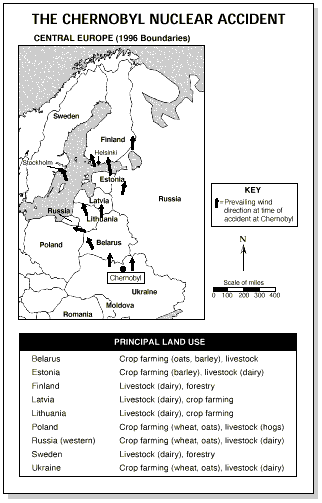
11 In April, 1986, the worlds worst nuclear accident took place when a reactor at the Chernobyl Power Station in Ukraine burned.
On the lines provided, describe one consequence of this accident in Ukraine and one consequence in an area north of Ukraine. Explain your answers.
Description and explanation of one consequence of the Chernobyl nuclear accident in Ukraine:
Description and explanation of one consequence of the Chernobyl nuclear accident north of Ukraine:
Directions: Read the following historical excerpts and use them with what you already know to answer the questions that follow.
TWO VIEWS OF THE COLONIES
This first excerpt is from the Declaration of the Causes and Necessity of Taking Up Arms by John Dickinson and Thomas Jefferson issued on July 6, 1775, after the battle at Bunker Hill.
But why should we enumerate [list] our injuries in detail? By one statute it is declared that Parliament can of right make laws to bind us in all cases whatsoever. What is to defend us against so enormous, so unlimited a power? Not a single man of those who assume it [power], is chosen by us; or is subject to our control or influence; . . . We for ten years . . . reasoned . . . with Parliament, in the most mild and decent language.
[The British] Administration, sensible that we should regard these oppressive measures as freemen ought to do, sent over fleets and armies to enforce them. . . . A Congress of delegates from the United Colonies was assembled at Philadelphia on the fifth day of last September [the First Continental Congress]. We resolved again to offer an humble and dutiful petition to the king....
Lest this declaration should disquiet the minds of our friends and fellow- subjects in any part of the Empire, we assure them that we mean not to dissolve that union which has so long and so happily subsisted between us, and which we sincerely wish to see restored. . . .
In our own native land, in defense of the freedom that is our birthright, . . . we have taken up arms.
This second excerpt is from a speech to Parliament by King George III of England on October 26, 1775.
It was declared in your last session [of Parliament] that a rebellion existed within the province of the Massachusetts Bay, . . . still hoping that my people in America would have discerned the traitorous views of their leaders, and have been convinced, that to be a subject of Great Britain,... is to be the freest member of any civil society in the known world.
The rebellious war now levied is become more general, and is manifestly carried on for the purpose of establishing an independent empire. I need not dwell upon the fatal effects of the success of such a plan. . . .
It is now become the part of wisdom and [in its effects] of clemency [mercy], to put a speedy end to these disorders by the most decisive exertions. For this purpose I have increased my naval establishment, and greatly augmented my land forces.
12 Which of the following BEST describes the conditions that existed at the time these passages were written?
A The British Empire was crumbling all over the world.
B The colonists had won the Revolutionary War.
C The British government ignored the actions of the colonists.
D The United States did not yet exist as a nation.
13 What type of government were the colonists rebelling against?
A Oligarchy
B Democracy
C Monarchy
D Republic
14 Which of the following statements BEST expresses the view that people like Jefferson in the colonies had of Great Britain?
A Britain was caring.
B Britain was oppressive.
C Britains army was too small.
D Britains Parliament was decent.
15 What event occurred as a direct result of the situations described in the passages?
A The War of 1812
B Queen Annes War
C The American Revolution
D The French and Indian War
16 How had the status of the colonists changed by 1783?
A From free people to servants
B From patriots to traitors
C From subjects to citizens
D From warriors to rebels
Directions: Read the following passages and use them with what you already know to answer the questions that follow.
TECUMSEH
About 200 years ago, Tecumseh was a chief of the Shawnee people who organized thousands of Indians Shawnee, Potawatomi, Kickapoo, and Winnebago under his leadership. Tecumseh saw clearly that Native Americans could never stop the loss of their land to white settlers unless the various tribes united. As long as the tribes were separate, tribal leaders could be persuaded to sell the land even land that belonged to other tribes.
When the War of 1812 began, Tecumseh joined the British against the United States. Tecumseh thought if the United States lost the war, the movement of white settlers west might be halted. Then, on October 13, 1813, Tecumseh was killed by American forces at the Battle of the Thames in southern Canada.
Part of the speech of Tecumseh when he met with the territorial governor, William Henry Harrison, in 1810.
Once . . . there was no white man on this continent. . . . It then all belonged to red men,*. . . placed on it by the Great Spirit that made them, to keep it,... to enjoy its productions, and to fill it with the same race. Once a happy race. Since made miserable by the white people, who are never contented but always encroaching [moving in].
The way, and the only way to check and stop this evil, is for all the red men to unite in claiming a common and equal right in the land. . . . For it never was divided, but belongs to all, for the use of each.... No part has a right to sell, even to each other, much less to strangers.... The white people have no right to take the land from the Indians because they [the Indians] had it first; it is theirs. They may sell, but all must join. Any sale not made by all is not valid.
* used in original source
17 Which of the following demonstrated Tecumsehs leadership?
A His ability to compromise with the United States government
B His wisdom in ending American Indian resistance against the United States government
C His wisdom in recognizing that American Indians must unite to stop the loss of their land to white settlers
D His willingness to put aside his anger at white settlers and lead his people in the fight against the British during the War of 1812
18 Which of the following events in United States history took place during Tecumsehs life?
A The Civil War between the North and the South
B The founding of the Spanish settlement in St. Augustine
C The founding of the British colonies in North America
D The movement of white settlers into the Northwest Territory
19 What was the situation after Tecumsehs meeting with the territorial governor?
A Only Tecumseh, among all the chiefs, was able to keep his peoples land.
B The British recognized that the Indians had a right to live on their own land.
C There was no improvement in the relationship between Native Americans and the United States government.
D The United States government honored most of the treaties made with the Shawnee, Potawatomi, Kickapoo, and the Winnebago.
20 According to Tecumseh, what crime were whites committing against all the native people of North America?
A Refusing to educate American Indian children
B Taking land that didnt belong to them
C Executing American Indians without giving them a fair trial
D Taxing American Indians without allowing them representation in Congress
21 How did Tecumsehs death in 1813 influence the course of United States history?
A The United States lost the War of 1812.
B Lacking unity, the American Indian tribes could not stop the spread of white settlement across the continent.
C Never again did Indians fight to protect their land.
D Feeling guilty for what they had done, whites halted their push westward onto American Indian lands.
Directions: You should take about 5 minutes to read the following passage and use it with what you already know to complete this task.
REVISING THE AMERICAN GOVERNMENT
In the spring of 1787, fifty- five delegates met in Philadelphia with the intention of revising the Articles of Confederation. Many of them soon realized that an entirely new document needed to be written. This document would lay the foundation for a new United States government. Before the United States Constitution was ratified, various plans were submitted and discussed. Following are recommendations from the Virginia Plan one of the plans under consideration.
From the Virginia Plan
The National Legislature ought to consist of two parts.
The number of representatives per state in the National Legislature will be based on the number of free inhabitants in each state.
22 On the lines provided, identify one reason why a state would support the Virginia Plan and one reason why another state would reject this proposed plan.
Identification of one reason a state would support the Virginia Plan:
Identification of one reason a state would reject the Virginia Plan:
Directions: Read the following imaginary information about a public policy issue. Use it with what you already know to complete the tasks that follow. You should take about 20 minutes to complete both Task I and Task II. Task I is a selected- response item and Task II is an extended- response item.
SCHOOL UNIFORMS
The school board is thinking about requiring all students in elementary and middle schools to wear uniforms to school. This issue has caused much discussion in the community. Read the following information about school uniforms.
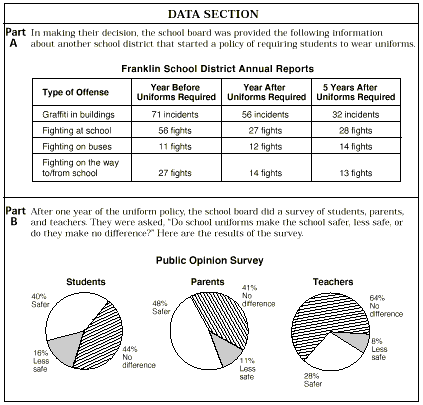
COMPLETE THE FOLLOWING TASKS:
Task I: Interpreting Information
23 Study the information in the Data Section. Which of the following statements best describes the relationship between graffiti and school uniforms? Be sure to mark your answer on the answer sheet.
A School uniforms caused graffiti to decrease.
B The longer school uniforms were required, the fewer incidents of graffiti were reported.
C The amount of graffiti caused fights to increase.
D The longer school uniforms were required, the more incidents of graffiti were reported.
Task II: Taking a Stand
24 You will now take a stand on the following public policy issue: Should school districts require students in elementary and middle schools to wear uniforms? You may either support or oppose school uniforms. Write a letter to the school board of the local school district. Use information to provide reasons that support your position.
You will be graded on the following, so be sure your letter includes each of the elements listed below:
A clear statement of your position
Supporting information using core democratic values of American constitutional democracy (See page 46 for examples.)
Supporting knowledge from history, geography, civics, or economics that you already know (It is not enough to state only your opinion.)
Supporting information from the Data Section
Remember to: Use complete sentences.
Explain your reasons in detail.
Write or print neatly on the lines provided below.
Should school districts require students in elementary and middle schools to wear uniforms?
Dear School Board Members:
Use this checklist to review your letter.
I stated my position clearly.
I supported my position with reference to at least one core democratic value of American constitutional democracy.
I supported my position with knowledge from history, geography, civics, or economics that I already knew.
I supported my position with information from the Data Section.
Day Two: Social Studies Assessment
Instructions to the Student
There are three types of questions on this test: selected- response, constructed- response, and extended- response. Selected- response questions will ask you first to read a passage, map, chart, or table. After studying this prompt, read the questions and choose the best answer from among four answer choices.
Constructed- response questions will ask you to explain a conclusion, provide examples, complete a chart, interpret information, or give a reason for an answer you have given.
Extended- response questions require you to write an answer that is more detailed and requires more thinking. These items ask you to interpret information from a set of data on an imaginary policy issue, identify a relationship presented in the Data Section, take a position for or against the policy, and give reasons supporting your position.
Use the separate answer sheet to mark your choice for the selected- response questions. Fill in the circle for your choice on the answer sheet. Remember to fill in the circle completely and cleanly, erasing any stray lines or marks.
Space is provided in the test booklet for you to write your answers for constructed- response and extended- response items. Read all directions for these items carefully. Samples of each type of question are provided for you on pages 2 5 of this test booklet.
If you finish early, you may check your work for Day Two only. Do not work on the Day One section of this test.
Directions: Read the following statements and use them with what you already know to answer the questions that follow.
INDIVIDUAL RIGHTS
The Magna Carta
The Magna Carta has been called the cornerstone of English liberty. It is a document that English barons forced King John to approve in 1215. It marked the first time that anyone limited the absolute power of the king. One of the rights guaranteed to English citizens was trial by jury.
Chief Justice John Marshall
Marbury v. Madison, 1803
The government of the United States has emphatically been termed a government of laws, and not of men. It will certainly cease to deserve this high appellation, if the laws furnish no remedy for the violation of a vested legal right. . . . An act of the legislature, repugnant to the Constitution, is void.
Justice Oliver W. Holmes
Dissent, UNITED STATES v. Schwimmer
If there is any principle of the Constitution that more imperatively calls for attachment than any other, it is the principle of free thought not free for those who agree with us, but freedom for the thought we hate.
Justice Oliver W. Holmes
Schenck v. United States, 1919
The character of every act depends on the circumstances in which it was done. The most stringent protection of free speech would not protect a man in falsely shouting fire in a theater and causing panic.
25 Which of the following statements is MOST accurate regarding ideas expressed by John Marshall?
A Public officials may make decisions based only on their opinions.
B The law applies only to certain individuals.
C All people, including the government and public officials, are bound by the same laws.
D By limiting what the people can do, the government has more power.
26 Which of the following actions could be
supported by the ideas of Oliver W. Holmes?
A Public marches organized by unpopular groups opposed to the government
B Prohibiting public demonstrations against the government
C A rule requiring all students to salute the flag during assemblies
D Banning books by an author who criticizes America
27 Which of the following statements MOST accurately reflects the ideas expressed by Justice Holmes?
A The right to free speech as granted by the United States Constitution is absolute.
B One can falsely shout fire as long as it does not seriously harm others.
C The right to free speech as granted by the United States Constitution is limited.
D Freedom of speech applies only to the spoken word.
28 Which of the following statements could be supported by both John Marshall and Oliver W. Holmes?
A Only the President of the United States is above the law.
B The United States Constitution is the supreme law of the land.
C A state government can pass a law against free speech in times of crisis.
D The English first learned about individual rights from the Declaration of Independence.
29 Which of the following MOST accurately summarizes the statements in Individual Rights on the prior page?
A The Bill of Rights permits individuals to do as they please.
B An individuals rights are protected as long as they do not interfere with the rights of others.
C An individuals rights are protected as long as they represent popular views.
D Dissent and public expressions of opposition are discouraged in a democracy.
Directions: Read the following passage and use it with what you already know to answer the questions that follow.
NEW JERSEY V. T. L. O.,* 1985
*T. L. O. = the initials of the person involved. In 1980 a high school teacher in New Jersey found T. L. O. and another girl smoking in the restroom. In the principals office, T. L. O. denied that she had been smoking and claimed that she did not smoke at all.
An assistant principal demanded to see T. L. O. s purse. In it he found cigarettes, rolling papers, marijuana, a large wad of dollar bills and letters indicating that T. L. O. was involved in selling marijuana. T. L. O. s mother was notified that T. L. O. was taken to the police station where she confessed to selling marijuana.
T. L. O. was found guilty of delinquency in juvenile court and sentenced to a years probation on the drug- selling charge. An appeal to the New Jersey Supreme Court overturned the juvenile court ruling. The high court held that (1) the search of T. L. O. s purse violated her 4th (protection against unreasonable searches and seizures) and 14th Amendments rights and, therefore, (2) both the evidence and her confession could not be used in court against her.
The case was appealed by New Jersey to the United States Supreme Court in 1985. The Supreme Court ruled in favor of New Jersey, stating that there was a legitimate need to maintain an environment in which learning can take place. Therefore, reasonable suspicion was enough to warrant a search.
30 Why did this case come to the United States Supreme Court?
A It involved a conflict between an individual and a state government.
B Searching students purses could occur in more than one state.
C It required interpretation of the constitutional protection against unreasonable search and seizure.
D All state court decisions are appealed to federal court.
31 This case made it to the Supreme Court, but it was possible that the Supreme Court might have turned it down. What could have been a reason for not hearing the case?
A The girl was a minor and she doesnt have the same rights as an adult.
B In this case the girl was obviously guilty of possession of marijuana.
C The Supreme Court agreed with the lower court.
D Federal courts have jurisdiction over local schools.
32 How does this Supreme Court ruling affect more than the state of New Jersey?
A It provides for the unlimited search of purses and seizure of contents throughout the United States.
B It guarantees the rights of privacy to students in all public schools for the sake of education.
C It will allow police officers to use reasonable suspicion for the purposes even though they are not in a school.
D It justifies search of purses and seizure of contents from book bags and lockers when the learning environment is threatened.
33 What was the legal issue the Supreme Court was ruling on?
A Due process of law
B Separation of powers
C Ex post facto
D Judicial preference
34 How does this Supreme Court ruling balance individual rights with the common good?
A Students only have rights that are granted by school officials.
B Limits can be placed on the exercise of individual rights.
C The will of the majority cannot be denied by a court.
D The Constitution is designed to promote majority rule over individual rights.
Directions: You should take about 5 minutes to read the following passage and use it with what you already know to complete this task.
COMPLAINTS AGAINST THE KING
Thomas Jefferson listed in the Declaration of Independence specific acts of King George III of England. These acts of the monarch were some of the reasons why the American colonies were breaking away from England. Two of the acts of George III are listed below.
From the Declaration of Independence
He has made Judges dependent on his Will alone, for the tenure [term] of their offices, and the amount and payment of their salaries.
He has affected [acted] to render [make] the Military independent of and superior to the Civil power.
35 On the lines provided, for each of these actions, identify and explain how the United States Constitution prevents these problems from occurring.
Identification and explanation of one way the United States Constitution prevents these problems from occurring:
Identification and explanation of another way the United States Constitution prevents these problems from occurring:
Directions: Read the following company description and use it with what you already know to answer the questions that follow.

36 Which of the following statements BEST reflects the role of the Superior Shirt Company in Tabville?
A It provides all the clothing needed by the community.
B It is the only source of taxation for the local government.
C It is a major employer of the citizens of the community.
D It is the only source of investment for members of the community.
37 If the United States government placed a tariff on cotton imported from other countries, what would be the effect on the Superior Shirt Company?
A Sales of shirts by the company would rise dramatically.
B Workers at the company would demand higher wages immediately.
C The companys costs would increase, thereby cutting into their profit.
D The price of shirts produced in foreign countries would increase, making it a better situation for the company.
38 Which of these would be a method of increasing profits for the next business year?
A Increase the amount of money spent on raw materials
B Build a large addition to the factory building
C Replace half of the unskilled workers with skilled workers
D Decrease labor and raw material costs
39 What is indicated by the data about the Superior Shirt Company?
A The manufacturing of shirts depends upon more skilled than unskilled workers.
B Superior Shirt Company is a sole proprietorship.
C People are the most expensive business cost.
D The manufacturing of shirts is highly dependent upon workers with little training.
40 If another similar company opened up for business in the same region as the Superior Shirt Company, what would be the LIKELY effect?
A The two companies would share the same ideas and the same distribution routes.
B Prices of shirts in the area may decline.
C The shirts produced by both companies would be of poorer quality than before.
D Wages for the unskilled workers at the companies would decrease.
Directions: Read the following passage and use it with what you already know to answer the questions that follow.
INTERNATIONAL TRADE
Regardless of a nations strength, it is still, to some extent, dependent on other nations for various materials such as petroleum, foodstuffs, and countless other commodities. New approaches to production and distribution of goods and services have led to an increasing worldwide interdependence between nations that is characterized by growing international trade.
International trade is often restricted by tariffs, taxes placed on goods imported from other countries, and import quotas, restrictions on the number of foreign goods entering the country. These restrictions on trade are imposed to help protect a countrys domestic economy. Yet if nations are to meet the needs of their societies, international trade is necessary. This has led to the formation of international trade organizations and economic agreements to encourage trade.
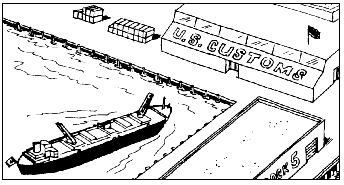
41 Which of the following is a MAJOR benefit of international trade free of tariffs?
A It helps a country become self-sufficient.
B It weakens the other countrys economy by using its natural resources.
C It makes more goods available at lower prices.
D It helps guarantee people will have jobs.
42 When would an import quota MOST likely be imposed on another countrys goods?
A Imported goods are selling at a much higher price than domestic goods.
B Domestic goods are priced higher than imported goods.
C There is favorable economic growth.
D There is a low demand for foreign raw materials.
43 Why are some tariffs called protective tariffs?
A They protect the federal treasury.
B They protect United States goods exported to other countries.
C They protect American products against competing foreign goods.
D They protect foreign goods when they come into the United States.
44 Should the overall economy of an industrialized nation be seriously affected by a change in demand for a single product?
A No, because industrialized nations usually produce many different products and do not solely rely on one or two products.
B No, because economies of industrialized nations no longer rely on demand to determine what and how much of a good is to be produced.
C Yes, because industrialized nations often rely on only one or two products.
D Yes, because industrialized nations are totally dependent on other nations for their products.
45 What was a purpose of the United States, Mexico, and Canada joining the North American Free Trade Agreement?
A To corner the market of a particular trade good
B To promote economic growth by reducing tariffs
C To encourage trade with European countries
D To exclude other countries from trading with members of the agreement
Directions: You should take about 5 minutes to read the following material and use it with what you already know to complete this task.
DEREGULATION
In the 1980s the airline industry was deregulated. The federal government could no longer tell an airline company where it could operate or how much it could charge.
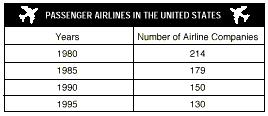
46 On the lines provided, identify a positive or a negative consequence of deregulation in the airline industry and explain why it is positive or negative.
Identification of a positive or negative consequence of deregulation: Explanation of why this consequence of deregulation is either positive or negative:
Directions: You should take about 5 minutes to study the following imaginary material and use it with what you already know to complete these tasks.
WORLDS LARGEST ARMED FORCES
Most of the nations of the world have armed forces. Listed below are the seven countries with the largest armed forces in the world.
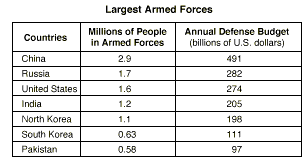
Task I:
47 Study the information in the table. Make a statement about the relationship between military size and annual defense budget.
Task II:
48 Use the information in the table to make a vertical bar graph showing the military strength of these countries. Correctly label the horizontal axis.
Seven Largest Armed Forces
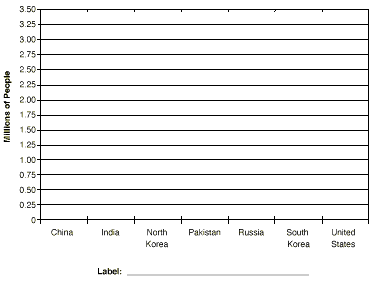
Directions: Read the following imaginary information about a public policy issue. Use it with what you already know to complete the tasks that follow. You should take about 20 minutes to complete both Task I and Task II. Task I is a selected- response item and Task II is a extended- response item.
STUDENT ATHLETES AND MANDATORY DRUG TESTING
The state legislature is considering a bill that would require random, mandatory testing of student athletes for illegal and/ or performance- enhancing drugs. Read the information below about this issue.
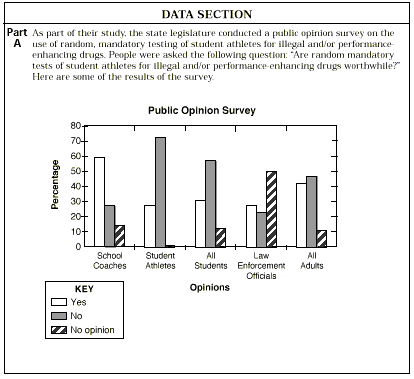
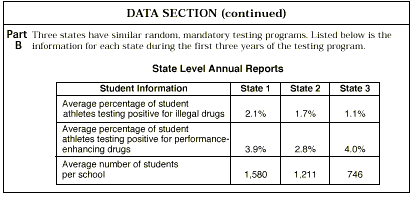
COMPLETE THE FOLLOWING TASKS:
Task I: Interpreting Information
49 Study the information in the Data Section. Which of the following statements best describes the relationship between size of student population and average percentage of student athletes testing positive for illegal drugs? Be sure to mark your answer on the answer sheet.
A As the average size of schools increases, the average percentage of student athletes testing positive for illegal drugs increases.
B The use of illegal drugs by student athletes causes school size to increase.
C School size causes increased use of illegal drugs by student athletes.
D As school size increases, illegal drug use by student athletes decreases.
Task II: Taking a Stand
50 You will now take a stand on the following public policy issue: Should the state legislature require student athletes to take random, mandatory tests for illegal and/ or performance- enhancing drugs? You may either support or oppose student athletes being required to take these tests for drugs. Write a letter to your state representative. Use information to provide reasons that support your position.
You will be graded on the following, so be sure your letter includes each of the elements listed below:
A clear statement of your position
Supporting information using core democratic values of American constitutional democracy (See page 46 for examples.)
Supporting knowledge from history, geography, civics, or economics that you already know (It is not enough to state only your opinion.)
Supporting information from the Data Section
Remember to: Use complete sentences. Explain your reasons in detail. Write or print neatly on the lines provided below.
Should the state legislature require student athletes to take random, mandatory tests for illegal and/ or performance- enhancing drugs?
Dear State Legislator:
Use this checklist to review your letter.
I stated my position clearly.
I supported my position with reference to at least one core democratic value of American constitutional democracy.
I supported my position with knowledge from history, geography, civics, or economics that I already knew.
I supported my position with information from the Data Section.
Some Core Democratic Values of American Constitutional Democracy
Core democratic values are the fundamental beliefs and constitutional principles of American society. These values unite all Americans. They are expressed in the Declaration of Independence, the United States Constitution, and other significant documents, speeches, and writings of the nation. Below is a list of some core democratic values. You may use any core democratic value to support your position including those not on this list. Be sure to explain how the value you choose supports the position you take.
Fundamental Beliefs
Life
Liberty
The Pursuit of Happiness
Public or Common Good
Justice
Equality
Diversity
Truth
Popular Sovereignty
Patriotism
Constitutional Principles
The Rule of Law
Separation of Powers
Representative Government
Checks and Balances
Individual Rights
Freedom of Religion
Federalism
Civilian Control of the Military
PART THREE: SCORING
HOLISTIC FEATURE SCORING OF CIVIC WRITING: GRADE 8
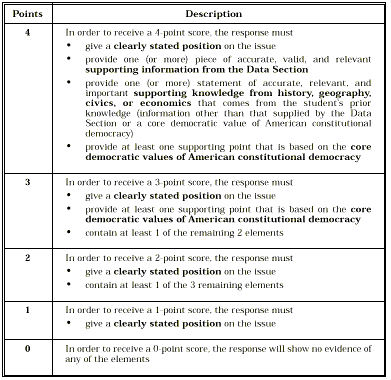
NOTE: The supporting points used by the student must be explained in enough detail to show a clear connection to the position taken.
STUDENT RESPONSES AND SCORING
The following comments are provided to help interpret the grade 8 student responses that follow. The notations in the right- hand column of the student response section refer to the elements the student is expected to address in the extended response items. Prior Knowledge (PK) shows where the answer addresses Supporting knowledge from history, geography, civics, or economics that you already know, and core democratic values (CDV) shows where the answer addresses Supporting information using core democratic values of American constitutional democracy. The first set of responses deal with the following public policy issue on pages 18 23: Should school districts require students in elementary and middle schools to wear uniforms?
Student Response (4 points)

SCORE 4
This student clearly stated a position: I dont think any student in a public school should have to wear uniforms. The data used logically supported the students position and were accurate: ... only the parents thought it was safer, but most of the students and teachers said it was no difference. They are the ones that are in school with each other, and you will think they would know. The core democratic value of American constitutional democracy that was cited applies to this public policy issue: ... freedom of expression. The student went beyond citing a core democratic value with an explanation of the connection: But, when we have to wear uniforms, we look the same every day and we dont get a chance to express ourselves. The position was supported with social studies knowledge from civics The United States Constitution is the supreme law of the land and takes precedence over local laws.
Student Response (3 points)

SCORE 3
This student clearly stated a position: I feel that uniforms should be worn in elementary and middle school. The core democratic value of American constitutional democracy that was cited applied to this public policy issue: common good. The student went beyond citing a core democratic value with an explanation of the connection: As citizens we also have the right to feel safe in our environment. The student supported the position taken with additional social studies knowledge from civics: The ideal in this country is that everyone should have the freedom to say and wear what they want that is the 1st amendment, but gangs use clothes to cause trouble someone has to stop them. This is clearly a reference to the enduring conflict between the rights of individuals and the good of society (the common good). Additional social studies knowledge supplied included knowledge that the freedom of speech is protected under the 1st amendment. No information from the data section was used in this response.
Student Response (2 points)

SCORE 2
This student clearly stated a position: I oppose school uniforms. Students should not be required to wear uniforms. The data used logically supported the students position and were accurate: ... according to the data, a great percentage of students and teachers think that there is no difference. This answer received no additional credit because it did not use a core democratic value of American constitutional democracy even though the student did support this answer with additional social studies knowledge from economics: scarcity, ... schools will have to buy them for students who cant afford them. Schools shouldnt spend money on uniforms when they can spend it on something educational like books or supplies that students really need. For an answer to receive the Score of 3 or higher the position must be supported with a core democratic value of American constitutional democracy.
Student Response (1 point)

SCORE 1
This student clearly stated a position: I support wearing school uniforms. This student received no additional credit for this answer. The student did not support the position taken with additional social studies knowledge from history, geography, civics, or economics. The student did not support the position with accurate use of data from the data section: in every category fighting and graffiti did not decrease. The student did not cite a core democratic value of American constitutional democracy.
The following comments explain how grade 8 students addressed the public policy question on pages 40 45: Should the state legislature require student athletes to take random, mandatory tests for illegal and/ or performance- enhancing drugs?
Student Response (4 points)
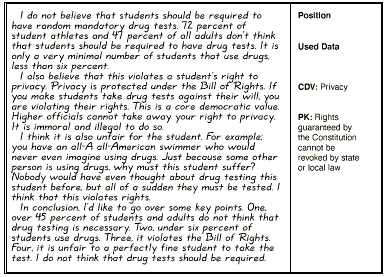
SCORE 4
This student clearly stated a position: I do not believe that students should be required to have random mandatory drug tests. The data used logically supported the students position and were accurate: 72 percent of student athletes and 47 percent of all adults dont think that students should be required to have drug tests. The core democratic value of American constitutional democracy that was cited applies to this public policy issue: privacy. The student went beyond citing a core democratic value with an explanation of the connection: Privacy is protected under the Bill of Rights. If you make students take drug tests against their will, you are violating their rights. The answer supported the position with social studies knowledge from civics the United States Constitution is the supreme law of the land and takes precedence over local laws.
Student Response (3 points)
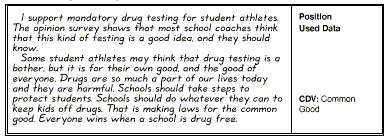
SCORE 3
This student clearly stated a position: I support mandatory drug testing for student athletes. The core democratic value of American constitutional democracy that was cited applied to this public policy issue: common good. The student went beyond citing a core democratic value with an explanation of the connection: Drugs are so much a part of our lives today and they are harmful. Schools should take steps to protect students.... The student supported the position taken with data from the data section: The opinion survey shows that most coaches think that this kind of testing is a good idea.... This student did not support the position taken with additional social studies knowledge from history, geography, civics, or economics.
Student Response (2 points)
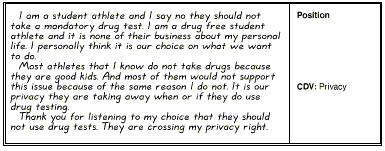
SCORE 2
This student clearly stated a position: I am a student athlete and I say no they should not take a mandatory drug test. The student did not use data from the data section to support this position. The core democratic value of American constitutional democracy that was cited applies to this public policy issue: privacy. The student went beyond citing a core democratic value with an explanation of the connection: I am a drug free student athlete and it is none of their business about my personal life. This student did not support the position taken with additional social studies knowledge from history, geography, civics, or economics.
Student Response (1 point)

SCORE 1
This student clearly stated a position: I think that it is a good idea to take a drug test for kids that want to be an athlete, and even adults. This student received no additional credit for this answer. The student did not support the position taken with additional social studies knowledge from history, geography, civics, or economics. The student did not support the position with accurate use of data from the data section. The student did not cite a core democratic value of American constitutional democracy.
CONSTRUCTED- RESPONSE SCORING GUIDE: GEOGRAPHY
Item #11 (pages 10 11)
A 2- point response describes AND explains one consequence of the Chernobyl accident in Ukraine AND one consequence of it north of Ukraine.
Examples:
a) In Ukraine:
1) People had to evacuate the area around the reactor.
2) Land around the area was contaminated.
3) People living near Chernobyl were harmed by the radioactive contamination.
4) Ground water was contaminated.
5) Crops and livestock were affected and they could not be used for food.
6) The safety of nuclear reactors was questioned.
b) North of Ukraine:
1) Winds blew radioactive contamination northward. Both crops and livestock as far north as Sweden and Finland were affected.
2) Economies were damaged.
3) People bought contaminated milk.
4) Concern over the location of nuclear power plants developed.
5) Nuclear power plants became viewed as dangerous to people.
A 1- point response describes and explains a consequence EITHER in Ukraine OR north of Ukraine.
CONSTRUCTED- RESPONSE SCORING GUIDE: HISTORY
Item #22 (pages 16 17)
A 2- point response gives one plausible reason why a state would support the proposed Virginia Plan AND one plausible reason why another state would reject the proposed Virginia Plan.
Examples:
a) Support:
1) The national legislature should consist of two parts because the one- part legislature of the Articles of Confederation did not work efficiently.
2) The number of representatives in Congress per state should be based on the number of free inhabitants in each state because that would give all free inhabitants the same representation.
3) A state with a large population would support this because it would have more representatives.
b) Reject:
1) The national legislature should consist of one part because two parts would make the government too large.
2) The number of representatives in Congress per state should not be based on the number of free inhabitants in each state because that would give the larger states like Virginia more power than smaller states like Rhode Island.
3) A small state would reject this because it would have fewer representatives than a large state.
CONSTRUCTED- RESPONSE SCORING GUIDE: CIVICS
Item #35 (pages 30 31)
A 2- point response describes how the United States Constitution prevents TWO of the problems with King George III of England from occurring.
Examples:
a) Judges depended on the king for their salaries and their tenure in office.
1) According to the Constitution, judges are paid by the taxpayers.
2) Some judges are elected by the taxpayers.
3) Federal judges are appointed by the president and approved by the Senate.
4) Supreme Court judges serve for life.
b) The military was independent and superior to the civilian government.
1) According to the Constitution, the president is commander- in- chief of the military.
2) The military is subject to the same laws as other citizens.
3) Promotions in the military are based on merit.
CONSTRUCTED- RESPONSE SCORING GUIDE: ECONOMICS
Item # 46 (pages 36 37)
A 2- point response identifies AND explains either a positive OR a negative consequence of deregulation in the airline industry. This could be from the consumers or the industrys point of view.
Examples:
a) Positive consequence:
1) Lower ticket prices
2) Airlines able to charge lower prices for some tickets
3) Increased profit OR
b) Negative consequence:
1) Reduced competition
2) Fewer airlines in the United States since deregulation began
3) Higher prices
Teacher note: Explanation must address either a positive OR a negative consequence.
a) Positive consequence explanation:
1) Only the most efficient airlines survive, and they have the lowest cost of operation.
2) Airlines with lower costs of operation can offer lower- priced tickets.
3) The number of airlines that continue operating share the total market of passengers and can earn more money from more business.
b) Negative consequence explanation:
1) There are fewer airlines, and that results in less competition for passengers.
2) Consumers have fewer choices when they decide to travel.
3) Prices could increase with fewer airlines because there is less competition.
CONSTRUCTED- RESPONSE SCORING GUIDE: INQUIRY
Page 38
Task I:
47 Study the information in the table. Make a statement about the relationship
between military size and annual defense budget.
The larger a country's military is, the more money that country spends on the military.
Full credit, i. e., 1 point, was given for the sample response shown above.
CONSTRUCTED- RESPONSE SCORING GUIDE: INQUIRY
Page 39
Task II:
48 Use the information in the table to make a vertical bar graph showing the military strength of these countries. Correctly label the horizontal axis.
Seven Largest Armed Forces
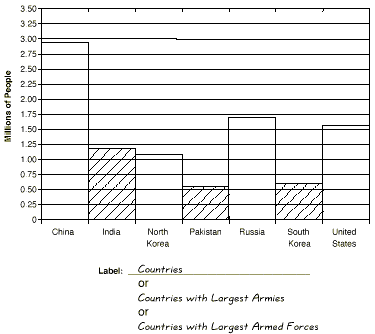
Full credit, i. e., 2 points, was given for the sample graph above.
SELECTED- RESPONSE ANSWER GRID
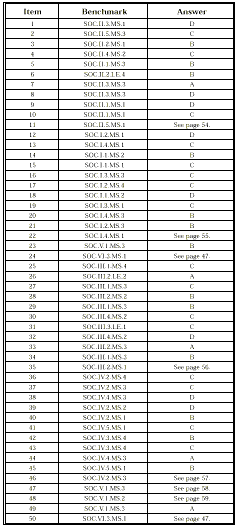
PART FOUR: RESOURCES AND ACKNOWLEDGMENTS
GLOSSARY
Analytic Scoring: The awarding of separate scores for different traits or dimensions of a students work.
Assessment: The gathering of evidence to judge a students demonstration of learning. Assessment aids educational decision making by securing valid and reliable information to indicate whether students have learned what is expected. Assessment is built around multiple indicators and sources of evidence (combinations of performances, products, exhibitions, discourse, tests etc.).
Benchmark: A statement of what students are expected to learn at various developmental levels (i. e., early elementary school, later elementary school, middle school, and high school) to indicate progress made toward meeting a content standard.
Cluster: A group of selected- response items pertaining to the same set of prompts on the statewide social studies tests.
Content: Subject matter from the disciplines of history, geography, American government, and economics and the problems and issues to which they are applied.
Content Standard: A statement indicating what students are expected to know and be able to do by the time they graduate. The 25 content standards for social studies are attributes of informed and responsible citizens and are the goals of the curriculum.
Context: General topics expected to be included in the content of a K 12 curriculum that serve as a basis for test items. For example, Michigan is a context for The MEAP Test Grade 5 and United States History Since 1815 is a context for the MEAP High School Test.
Constructed Response: A type of test item that requires students to generate a reply that they have created based upon their prior knowledge and information presented in a prompt at the time of testing. A constructed response will take students roughly five minutes to complete and could be expressed in various forms, e. g., a paragraph, table, map, chart, or graph.
Core Democratic Values: The fundamental beliefs and constitutional principles of American society expressed in foundational documents of the United States such as the Declaration of Independence and the Constitution.
Curriculum: A coherent plan for a designated period of time specifying the content that students are expected to understand and apply. A curriculum normally includes standards, benchmarks, and a sequence of content that serve as the basis for instruction and assessment.
Elaborate: To analyze, explain, or support a claim by making additional statements. For some constructed- response and extended- response test items, students are expected to elaborate claims they make when responding.
Extended Response: A type of test item that allows students 20 minutes to compose an elaborated essay based upon their prior knowledge and information presented in a prompt at the time of testing.
Holistic Scoring: Scoring based on an overall impression of a work rather than on an accumulation of points.
Instruction: The decisions and actions of teachers before, during, and after teaching to increase the probability of student learning.
Performance Standards: A description of performance levels based on social studies content standards and benchmarks. Performance standards serve as a bridge between what is taught and what is tested.
Persuasive Essay: A written composition that expresses a position on an important public issue and supports the position with reasoned argument.
Prompt: Information presented in a test item that activates prior knowledge and requires analysis in order for a student to respond. A prompt could be a passage, map, chart, graph, drawing, photograph, or combination of these.
Scoring Guide: A scoring guide is a tool for evaluating student performance on an assessment task. It includes a set of criteria used to compute a score that represents the caliber of a students performance. These criteria are sometimes called a rubric.
Selected Response: A type of test item, sometimes called enhanced multiple choice, that requires students to select a response from a group of possible choices. Social studies selected- response items will pertain to a prompt and be presented in clusters. They will require students to remember what they are expected to know from a curriculum and to analyze information presented by the prompt.
Subject Area: A body of content derived from related disciplines and organized for curriculum. Social studies is one of four subject areas in the Michigan Model Academic Core Curriculum. The other three subject areas are English language arts, mathematics, and science.
Strand: A category for classifying the content standards of a subject area curriculum. The social studies content standards are categorized into seven strands: historical perspective, geographic perspective, civic perspective, economic perspective, inquiry, public discourse and decision making, and citizen involvement.
Testing: The systematic collection of information about a students knowledge and skills with a standardized instrument. Tests are one aspect of a comprehensive system for educational assessment.
SOCIAL STUDIES EDUCATION RESOURCES
Michigan Council for the Social Studies
Michael Yocum 2100 Pontiac Lake Road Waterford, MI 48328 (248) 209- 2037
Michigan Department of Education
Bruce Brousseau Michigan Educational Assessment Program (MEAP) P. O. Box 30008 Lansing, MI 48909 (517) 335- 0568
Karen R. Todorov Curriculum Development Program P. O. Box 30008 Lansing, MI 48909 (517) 373- 2893
Michigan Council for History Education
James McConnell Dearborn Public Schools Ten Eyck Administration Center 18700 Audette Dearborn, MI 48124 (313) 730- 0150
Michigan Geographic Alliance
Michael Libbee Central Michigan University 294 Dow Science Hall Mount Pleasant, MI 48859 (517) 774- 3723
Center for Civic Education Through Law
Linda Start 2100 Pontiac Lake Road Waterford, MI 48328 (248) 209- 2325
Economics America of Michigan
Patricia Bonner Executive Director 37000 Grand River Avenue, Suite 365 Farmington Hills, MI 48335 (248) 888- 1075
SOURCES FOR NATIONAL CURRICULUM STANDARDS
Curriculum Standards for Social Studies: Expectations of Excellence
National Council for the Social Studies 3501 Newark Street, NW Washington, DC 20016- 3167 (202) 966- 7840
National Standards for United States History: Exploring the American Experience
National Center for History in the Schools University of California, Los Angeles 1100 Glendon Avenue, Suite 927 Los Angeles, CA 90024- 4108 Fax: (310) 825- 4723
National Standards for United States History: Exploring Paths to the Present
National Center for History in the Schools University of California, Los Angeles 1100 Glendon Avenue, Suite 927 Los Angeles, CA 90024- 4108 Fax: (310) 825- 4723
National Standards for History: Expanding Childrens World in Time and Space
National Center for History in the Schools University of California, Los Angeles 1100 Glendon Avenue, Suite 927 Los Angeles, CA 90024- 4108 Fax: (310) 825- 4723
Geography for Life: National Geography Standards 1994
National Geographic Society P. O. Box 1640 Washington, D. C. 20013 (800) 368- 2728
National Standards for Civics and Government
Center for Civic Education 5146 Douglas Fir Road Calabasas, CA 91320- 1467 (800) 350- 4223
A Framework for Teaching Basic Economic Concepts
National Council on Economic Education 1140 Avenue of the Americas New York, NY 10036 (800) 338- 1192